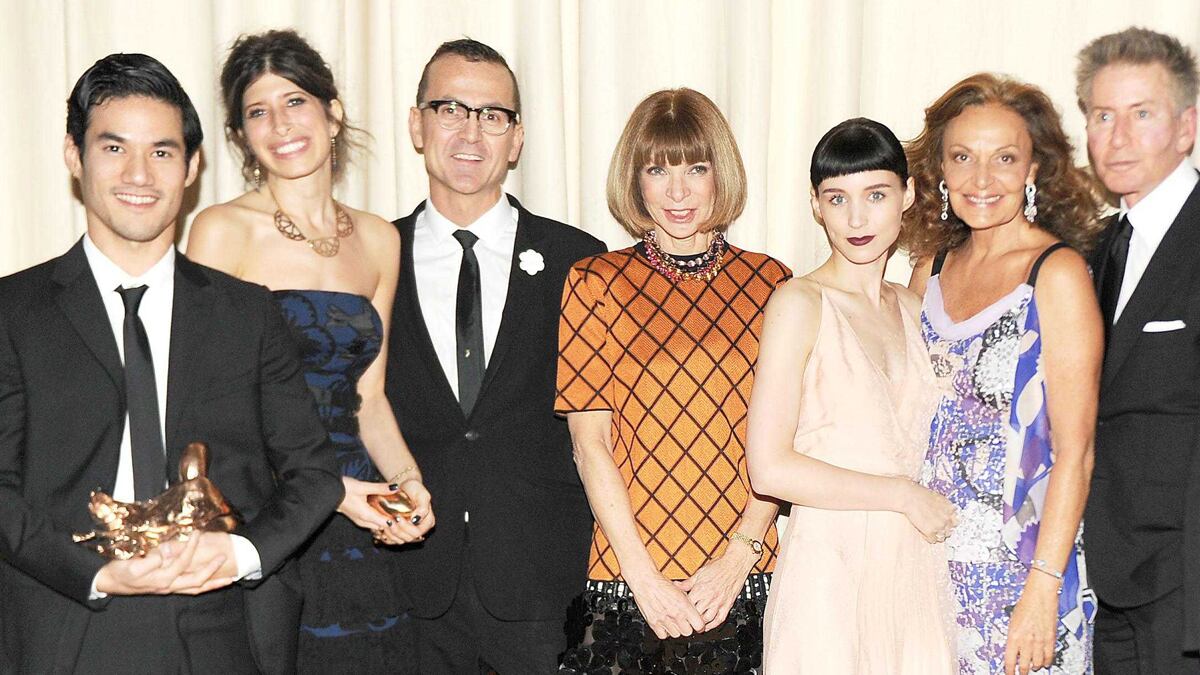
From their beginning eight years ago, the CFDA/Vogue Fashion Fund Awards have always aimed to give up-and-coming designers something more than just an egg-shaped award—created by Rachel Feinstein—and $100,000 for the two runners-up and $300,000 for the winner. The point has always been to try and give talented U.S.-based designers the best shot at a long, satisfying career. The award doesn’t so much celebrate what designers have done—although that certainly matters—but instead, honors them for what they have the capacity to do in the future.
Previous winners have included Doori Chung, who recently dressed first lady Michelle Obama for the South Korea state dinner at the White House, Proenza Schouler and Alexander Wang—whose businesses have matured to the point of even launching other careers.
Now the Council of Fashion Designers of America and Vogue magazine are betting that this year’s winner, Joseph Altuzarra, has what it takes to build a lasting brand in the frock business. Altuzarra was born in Paris and now runs his own company in New York after previous experience working at Marc Jacobs, Proenza Schouler, and Givenchy. One of Altuzarra’s most distinctive and acclaimed collections was for fall 2011, which mixed luxurious, bias-cut, grunge-inspired plaid dresses with oversized fur-trimmed army parkas. His tailoring is European in its precision and his aesthetic attitude is pure urban Americana.
Altuzarra—although not tall, is dark-haired and handsome, which in fashion never hurts—has received an avalanche of media attention. But he is also being embraced by retailers, who believe he has something to say that is both distinctive and commercial.
This year’s two runners-up included jewelry designer Pamela Love, who has created custom pieces for HBO’s True Blood, and the brand Creatures of the Wind, which is designed by School of the Art Institute of Chicago graduates Shane Gabier and Chris Peters. After the awards, with cameras flashing and well-wishers moving in to offer congratulations, Gabier and Peters stood with smartphones clutched to their ear to share news of their win with their respective mothers.
Even more important than the cash award, the winners also receive business mentoring, which create relationships that can go on for years. Winning designers have gone on to be advised by the likes of former Gucci honcho Domenico de Sole, past president of Barneys New York Howard Socol and Jenna Lyons of J.Crew. The business mentoring goes to the heart of the awards, which are meant to serve as a high-level tutorial in the ways of the fashion business. The designers know this as well: in their acceptance speeches, each remarked on and praised the “process” of applying for the fund, which demanded that they not merely think about aesthetics but also about business.
The Fashion Fund Awards are, perhaps, the least glamorous of fashion’s big nights out. Designers, in general, do not arrive with a posse of Hollywood stars in tow as they so often do at the CFDA awards in June. Unlike the Metropolitan Museum of Art’s Costume Institute gala, the Fashion Fund Awards aren’t about creating a dazzling tableau vivant with over-the-top ball gowns and bold-face names.
Monday night at Skylight Soho in New York, there was no red-carpet melee of young starlets dressed by the finalists—which this year included Ohne Titel, Carlos Campos, A. A. Antonio Azzuolo, Cushnie & Ochs, Fenton/Fallon, Finn Jewelry, and Suno. There were photos, of course, but no wailing hordes of paparazzi. Inside, the rustic dinner tables were adorned with colorful tulips. The main course was the most efficient of comfort foods: chicken pot pie. And the room was sprinkled with only a hint of Hollywood glitter, with actress Rooney Mara from The Girl With the Dragon Tattoo, helping to dispense the awards. (Mara, of course, has that other-worldly star aura: remarkably perfect skin and a body from Lilliput.) Mostly, the night hewed to its mission: attending to burgeoning design houses.
Proving how the night is about the business of fashion rather than the glitz, the evening’s keynote speech was delivered by Calvin Klein, who didn’t regale the audience with tales of his Studio 54 days or other glossy escapades but instead talked bout the jobbers and production workers, Teamsters, delivery trucks, and brushes with the mob.
Dressed in a simple black suit and white shirt, Klein described how he launched his business back in 1968 with a collection of four coats and three dresses, an investment of $10,000 and the help of his childhood friend Barry Schwartz. Klein, reading from notes, explained how he booked a room—No. 613 as he recalled—at an old Manhattan hotel favored by out-of-town manufacturers. All these years later, Klein still could describe the weekend his career took off: it began on a Thursday evening, he said, when a representative from Bonwit Teller, at the time one of the top specialty store chains in the country, arrived to look at the clothes. Liking what he saw, the brusque merchant explained that he’d be sending a buyer over the next day. And on Saturday, Klein would meet the company president. And then in the telling of the story, Klein paused. He still remembers the exact words of the merchant: “And then you will have been discovered.”
Three days after officially opening his business, Klein had a $50,000 order from Bonwit Teller.
It’s unclear whether such a magical tale was reassuring or daunting to the young designers listening, but Klein made clear that even the best kind of luck has to be paired with hard work in order to find lasting success. Klein described spending seven days a week in his tiny showroom and collapsing on the floor at the end of each night, sleeping for a few hours and then starting all over again the next morning. His mentors, he said, were production folks who taught him about the manufacturing process. He had to feign confidence even when he lacked it. “And I say this to creative people who are often so afraid of the business side: Just deal with things one at a time. Everything is solvable.”
But there’s one major difference between Klein’s early days and today’s emerging designers: While he might have had to negotiate with gangsters who “volunteered” their truck delivery services, he didn’t have to compete on the global stage when his company was just in its infancy like designers do now. In today’s market, designers must speak to an international audience, even when they’re still honing their message.
To help prepare these fledgling designers for the global market, Vogue editor Anna Wintour announced a new initiative called the China Design Program. It will be a kind of cultural exchange that sends American designers to China to learn about manufacturing, marketing, and other aspects of the fashion business there—and a Chinese designer spends time in the U.S. It is, Wintour said, a version of cultural diplomacy that will also help American designers expand their customer base. Lazaro Hernandez and Jack McCollough of Proenza Schouler will be the first participants next year.
It may not sound especially glamorous, but the hard work of fashion rarely ever is.






